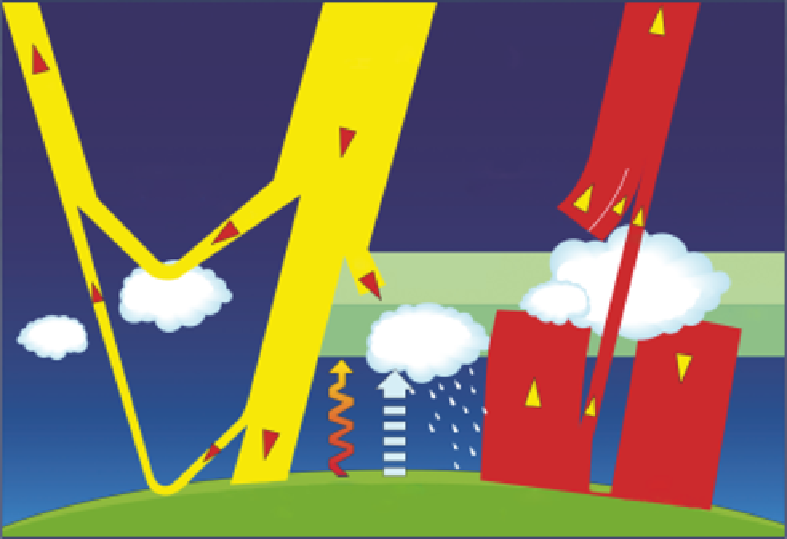Environmental Engineering Reference
In-Depth Information
the upper atmosphere is impacted by the relative distance from the sun to the earth and declination,
which vary over the course of a year. The amount of light reaching the upper atmosphere at a par-
ticular location depends on factors such as the latitude and the time of day. All of these factors are
very predictable and are included in many heat budget models (Martin and McCutcheon 1999). Of
the light reaching the upper atmosphere, some is relected by the atmosphere and some is damped
by scattering and absorption by dust and atmospheric moisture.
The light reaching the water surface of streams and rivers, in the form of heat energy, along with
other processes, impacts the water temperature, as will be discussed in the following section. Some
of the light reaching the water surface is direct solar radiation (shortwave radiation) and some of
the light is relected from clouds (typically longwave radiation) (Figure 5.4). Shortwave radiation
is composed of ultraviolet, visible light and near-infrared radiation with wavelengths of about 200
and 4000 nm. Longwave radiation is composed of infrared radiation with wavelengths of about
4,000-100,000 nm.
Light also directly impacts photosynthetic organisms in rivers and streams. Chlorophylls a, b,
and c are common pigments used by plants and chlorophyll concentrations are often used as an esti-
mate of plant biomass since it is easier to measure concentrations of these pigments than to measure
biomass. Chlorophylls absorb light most strongly in the red and violet parts of the spectrum, while
green light is poorly absorbed. Typically, the conversion to energy involves absorbing a wavelength,
extracting the energy, and then emitting light at a longer wavelength (less energy). The process is
called luorescence and it can be used to measure chlorophyll concentrations using devices such
as a luorometer. Essentially, light of a certain wavelength is emitted (an excitation beam) and the
strength of the light luoresced is an indication of the amount of chlorophyll present. The excitation
beam is typically in the blue range (440-460 nm depending on the analysis) and the light emitted
and measured is in the red range (685 nm). Only chlorophyll-a can use light to produce chemical
energy, while chlorophyll-b and c are accessory pigments, which help capture and transfer the
Reflected solar
radiation
107W m
-2
Incoming solar
radiation
342W m
-2
Outgoing longwave
radiation
235W m
-2
235
107
342
Reflected by
clouds, aerosol,
and atmosphere
77
Emitted by the
atmosphere
165
Atmospheric
window
40
77
30
40
Absorbed by the
atmosphere
67
Greenhouse
gases
Latent
heat
24
78
324
Back
radiation
Reflected by
the surface
30
350
40
168
Absorbed by
the surface
390
Surface
radiation
324
Absorbed by
the surface
ermals
24
Evapotrans-
piration
78
FIGURE 5.4
Solar radiation budget. (From NASA, Available at http://ceres.larc.nasa.gov/ceres_brochure.
php?page = 2.)

Search WWH ::

Custom Search